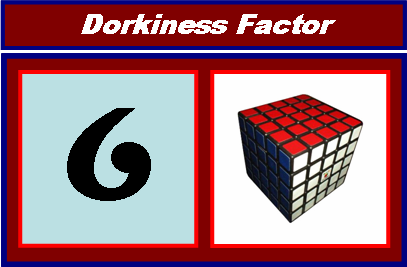The Formula That Plots Itself
Tupper’s Self-Referential Formula: That’s So Meta
This formula, much like Benford’s Law, is either going to seem ho-hum, or is going to BLOW YOUR MIND INTO A NEW PLANE OF EXISTENCE! Or, more likely, you’ll find it really fascinating but your friends won’t, and those friends are already wishing you’d shut up about it, even though you haven’t told them yet. Which you can’t, because I haven’t told you yet. Tupper’s Self-Referential Formula is an astounding little mathematical formula, that when you plot it, it prints out a picture of itself.
Got that? Just like a quadratic equation y = x2 will render a cute little smiley curve shape when drawn out, and y = [x] prints out a little staircase when plotted, Tupper’s formula will generate a pretty decent-looking rendition of itself in mathematical symbols, complete with the equals sign and parentheses and whatnot. Specifically, the following mathematical formula,
will generate the following picture, when you graph it for particular values of X and Y:
Now, if you don’t think that’s cool, then you need to leave this website. Now. Because we just aren’t going to connect, on a fundamental level. No no, it’s not you, it’s me.
Are they gone? Nobody left but us squares? Good! Isn’t this equation just freaking crazy? I can’t even begin to fathom how this was done. This is probably the craziest example I’ve ever seen of a Quine, or a self-referencing bit of math, logic, or language. Another, more famous example is the common liar’s paradox sentence “This sentence is false“, which clearly contradicts itself, and so is neither true nor false. (Which makes it handy for ferreting out clandestine androids in your circle of friends, whose heads will explode in a shower of springs and gears upon reading the sentence.) Other examples abound in the works of M. C. Escher — there should be a couple Escher prints somewhere on the walls of your office right now, if you have made it this far in this article.
In case you’re not duly impressed with the self-referential formula nor the other self-referencing examples mentioned above, be warned that you’re a tresspassing unbeliever in a rich vein of philosophical nerdiness surrounding self-reference. Logical structures that are capable of referring to themselves (like language, math, or computer programs) are not only cool, but underlie the single most revolutionary discovery made in mathematics probably since Calculus, none other than Godel’s Incompleteness Theorem. If you are starting to sense that I’m about to bring up Douglas Hofstadter, then you’re an avid reader of this website. He’s written one of the very best science books of all time, Godel Escher Bach: an Eternal Golden Braid, which explains in detail just how cool self-referential structures are, how they underlie the proof of Godel’s Theorem, what this theorem does to the logical foundations of Mathematics, and finally what this may mean for human consciousness. Intrigued? Then by all means, don’t let us stop you from visiting the Timeblimp book review of Godel, Escher Bach. (Oh, and you may also want to read the book itself, in case you want to get all the details.)
But back to Tupper’s Formula. While I’m no expert (and certainly haven’t read his publication in which this formula was announced), I suspect it might seem a bit more natural to those folks who make their living in the computer graphics world. It apparently arises from work Tupper has done on better mathematical graphing software, an area that may seem straightforward to most of us but deserves some careful thought. His self-plotting formula is just one exercise in a range of work he’s done in improving graphics for mathematical work. Still, that is pretty freaking cool. I’d say it’s my favorite nerdy topic I’ve come across in years. If you’ll excuse me, I’ve got some friends to go annoy…


 Follow Timeblimp on Twitter
Follow Timeblimp on Twitter